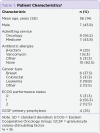Assessment of Initial Febrile Neutropenia Management in Hospitalized Cancer Patients at a Community Cancer Center
- PMID: 31186987
- PMCID: PMC6505658
Assessment of Initial Febrile Neutropenia Management in Hospitalized Cancer Patients at a Community Cancer Center
Abstract
Fever may be the only sign of an underlying infection in neutropenic cancer patients. Unrecognized fever and untreated infections can lead to progressive sepsis and possibly death. The importance of early recognition, timely antibiotics, and treatment is crucial to favorable outcomes. The primary objective of this study was to evaluate the treatment of adult cancer patients with febrile neutropenia for compliance with National Comprehensive Cancer Network (NCCN) febrile neutropenia guidelines at our institution, UCHealth Memorial Hospital. Secondary objectives were to examine antibiotic selection, culture results, time to antibiotics, all-cause mortality, and length of hospital stay. This was a single-center, retrospective chart review of hospitalized neutropenic patients undergoing active chemotherapy. Neutropenia and fever were defined based on NCCN Guidelines. A total of 223 neutropenic patients were hospitalized between October 15, 2015, and December 31, 2016. Overall, 16 patients met the inclusion criteria for chemotherapy-induced neutropenia with fever. Compliance with the NCCN guideline standards was seen in seven (43.8%) patients. Antibiotics administered within 60 minutes of presentation was the lowest standard with adherence in eight (50%) patients. Empiric monotherapy antibiotic regimens were initiated in 11 (68.8%) patients; eight (50%) received cefepime and three (18.8%) received meropenem. At our institution, full compliance with the NCCN febrile neutropenia guidelines is not optimal. This study demonstrates the need for process improvement initiatives, including the addition of an electronic health record alert to flag patients undergoing active chemotherapy. It also warrants promoting the use of our institution's emergency department febrile neutropenia treatment pathway to providers to improve overall compliance.
Figures
Similar articles
-
Febrile Neutropenia: Decreasing Time to Antibiotic Administration in a Community Hospital Emergency Department.Clin J Oncol Nurs. 2021 Feb 1;25(1):23-26. doi: 10.1188/21.CJON.23-26. Clin J Oncol Nurs. 2021. PMID: 33480869
-
Meropenem versus piperacillin-tazobactam as empiric therapy for febrile neutropenia in pediatric oncology patients.Asian Pac J Cancer Prev. 2014;15(11):4549-53. doi: 10.7314/apjcp.2014.15.11.4549. Asian Pac J Cancer Prev. 2014. PMID: 24969883
-
[Prevention and treatment of febrile neutropenia].Tumori. 1997;83(2 Suppl):S15-9. Tumori. 1997. PMID: 9235724 Review. Italian.
-
[Cefepime as an empiric treatment of febrile neutropenia in patients after high dose therapy and autologous stem cell transplantation].Cas Lek Cesk. 2006;145(5):383-6, 388-9. Cas Lek Cesk. 2006. PMID: 16755776 Czech.
-
Can mortality of cancer patients with fever and neutropenia be improved?Curr Opin Infect Dis. 2015 Dec;28(6):505-13. doi: 10.1097/QCO.0000000000000202. Curr Opin Infect Dis. 2015. PMID: 26374951 Review.
Cited by
-
A sequential exploratory study to develop and validate neutropenic nursing care bundle for neutropenic patients admitted in a tertiary care hospital, Uttarakhand.J Educ Health Promot. 2022 Aug 25;11:267. doi: 10.4103/jehp.jehp_241_22. eCollection 2022. J Educ Health Promot. 2022. PMID: 36325211 Free PMC article.
-
Evaluation of the Management of Febrile Neutropenia in a Tertiary Care Center.Can J Infect Dis Med Microbiol. 2025 Apr 8;2025:3681955. doi: 10.1155/cjid/3681955. eCollection 2025. Can J Infect Dis Med Microbiol. 2025. PMID: 40236690 Free PMC article.
References
-
- Keng Michael K, Thallner Elaine A, Elson Paul, Ajon Christine, Sekeres Jennifer, Wenzell Candice M, Seastone David J, Gallagher Erika M, Weber Catherine M, Earl Marc A, Mukherjee Sudipto, Pohlman Brad, Cober Eric, Foster Virginia B, Yuhas Joy, Kalaycio Matt E, Bolwell Brian J, Sekeres Mikkael A. Reducing Time to Antibiotic Administration for Febrile Neutropenia in the Emergency Department. Journal of oncology practice. 2015;11:450–455. - PubMed
-
- Ko Byuk Sung, Ahn Shin, Lee Yoon-Seon, Kim Won Young, Lim Kyung Soo, Lee Jae-Lyun. Impact of time to antibiotics on outcomes of chemotherapy-induced febrile neutropenia. Supportive care in cancer : official journal of the Multinational Association of Supportive Care in Cancer. 2015;23:2799–2804. - PubMed
-
- National Comprehensive Cancer Network. NCCN Clinical Practice Guidelines in Oncology: Prevention and Treatment of Cancer-Related Infections. v2.2017. 2017 Retrieved from https://www.nccn.org/professionals/physician_gls/pdf/infections.pdf.
-
- Rhodes Andrew, Evans Laura E, Alhazzani Waleed, Levy Mitchell M, Antonelli Massimo, Ferrer Ricard, Kumar Anand, Sevransky Jonathan E, Sprung Charles L, Nunnally Mark E, Rochwerg Bram, Rubenfeld Gordon D, Angus Derek C, Annane Djillali, Beale Richard J, Bellinghan Geoffrey J, Bernard Gordon R, Chiche Jean-Daniel, Coopersmith Craig, De Backer Daniel P, French Craig J, Fujishima Seitaro, Gerlach Herwig, Hidalgo Jorge Luis, Hollenberg Steven M, Jones Alan E, Karnad Dilip R, Kleinpell Ruth M, Koh Younsuk, Lisboa Thiago Costa, Machado Flavia R, Marini John J, Marshall John C, Mazuski John E, McIntyre Lauralyn A, McLean Anthony S, Mehta Sangeeta, Moreno Rui P, Myburgh John, Navalesi Paolo, Nishida Osamu, Osborn Tiffany M, Perner Anders, Plunkett Colleen M, Ranieri Marco, Schorr Christa A, Seckel Maureen A, Seymour Christopher W, Shieh Lisa, Shukri Khalid A, Simpson Steven Q, Singer Mervyn, Thompson B Taylor, Townsend Sean R, Van der Poll Thomas, Vincent Jean-Louis, Wiersinga W Joost, Zimmerman Janice L, Dellinger R Phillip. Surviving Sepsis Campaign: International Guidelines for Management of Sepsis and Septic Shock: 2016. Intensive care medicine. 2017;43:304–377. - PubMed
Publication types
LinkOut - more resources
Full Text Sources
Miscellaneous




